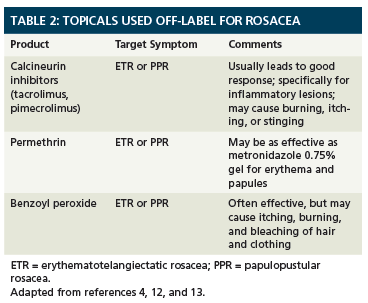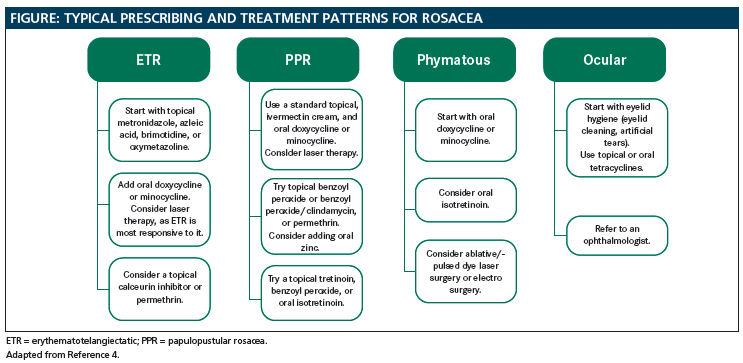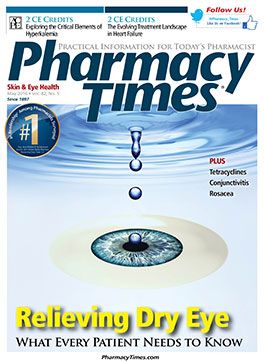Publication
Article
Pharmacy Times
Rosacea: A New Crop of Treatments
Author(s):
Rosacea, a chronic inflammatory condition usually involving the face and the eyes, affects 16 million Americans of all genders, ages, races, and ethnicities.
Rosacea, a chronic inflammatory condition usually involving the face and the eyes, affects 16 million Americans of all genders, ages, races, and ethnicities.1 Symptoms generally appear when patients are in their thirties or forties, and wax and wane throughout life.2
Rosacea can occur in anyone, but its clinical presentation varies substantially. Certain symptoms are common (Table 13), but symptoms can occur along a spectrum and often together.4

Rosacea’s pathophysiology is still largely unknown. Researchers have determined that blood vessel dilation, infiltration of T-helper cells, macrophages, and mast cells are frequent histologic findings. In addition, keratinocyte Toll-like receptors are cited as having a likely role in the pathogenic process of unwarranted activation of the immune system.4
Treatment
Pharmacologic treatment of rosacea is neither curative nor the sole option, and nonpharmacologic interventions are critical to successful treatment. Patients also must avoid triggers (eg, sunlight, hot food, exercise, alcohol, ultraviolet light exposure, hot showers).5 The associated drug therapies are topical or systemic. Each category includes FDA-approved and unapproved options, and some homeopathic possibilities. In addition, whereas light or laser therapies are often used to treat redness and skin thickening, patients’ insurance often does not cover this costly option. Because no therapy is considered curative, patients often have to try many medications and combinations of them to find what works best.4
Topical Treatments
The FDA approved brimonidine tartrate gel (Mirvaso), an alpha-2 agonist, in 2013. It is the only product approved for persistent facial flushing.2,4,6 This gel reverses vasodilation, reducing redness.4 Patients should apply a pea-size amount to the face once daily. The adverse effects (AEs) are mostly mild and often cutaneous, occurring at treatment initiation. Several reports of rebound erythema have been reported, however. This medication can be used in combination with other therapies, including those used to treat papules.6
Some rosacea sufferers use oxymetazoline to treat redness and flushing of the face. It has alpha-1 and alpha-2 effects and causes vasoconstriction. A facial formulation is currently in clinical development; however, doctors may recommend patients purchase the 0.05% nasal solution and apply it topically.4
Metronidazole, a cornerstone of papulopustular rosacea (PPR) treatment, comes in 0.75% and 1% formulations in different vehicles and is applied once or twice daily. Its exact mechanism of action is unknown, but it seems to have antimicrobial, antioxidant, and anti-inflammatory properties.7,8
Azelaic acid (Finacea) is another FDA-approved agent that is safe and effective for PPR.4,6 It is available as a 15% gel and is applied twice daily. It decreases enzyme activity and immune system activation,2 and it has anti-inflammatory, antimicrobial, and antioxidant benefits.2,6
Combination sulfacetamide 10%/sulfur 5% is available in many formulations, although these preparations are rarely used. These products can cause irritation and allergic reaction, and are malodorous.4 Their efficacy is questionable, based on a small number of clinical trials and mixed findings.2,4
The FDA recently approved once-daily ivermectin 1% cream (Soolantra) to treat PPR. Phase 3 trials proved it to be safe and effective at 12 weeks. It is thought to reduce papules by killing Demodex mites, which live in the sebaceous glands.9-11 The AEs include burning, itching, and dryness at the application site.2 Despite only a few clinical trials, numerous other topicals are also effective and used off-label (Table 24,12,13).

Systemic Treatments
Doxycycline 40 mg (Oracea) works through numerous mechanisms to treat PPR.4 This once-daily sub-antimicrobial dose decreases antibiotic selection.2,4,6 Studies have shown it to be effective as monotherapy and when used in combination with topicals such as metronidazole and azelaic acid.4
Isotretinoin is a last-line option for patients with refractory rosacea. Generally thought to treat PPR, it also benefits erythematotelangiectatic rosacea. Isotretinoin is a retinoid derivative that reduces the size of sebaceous glands and sebum production. Prescribed at various doses, isotretinoin has been shown to be more effective than doxycycline. However, isotretinoin creates greater risk of AEs such as fragile, sensitive skin.14,15
Zinc sulfate appears to be beneficial in small clinical trials. Zinc supplementation is relatively benign, with no AEs reported in clinical trials. Further research is warranted.4,16,17
Lasers and Light Therapy
Light therapy can be used to treat multiple subtypes and presentations of rosacea. Pulsed dye laser uses light wavelengths specific for the absorption of oxyhemoglobin, which targets superficial vasculature and decreases erythema.4
Another option, intense pulsed light (IPL) is more flexible and offers many benefits (eg, less discomfort, higher efficacy). In addition, IPL systems can target deeper blood vessels.4 With numerous types of lasers available, physicians must work closely to customize the best regimen for each patient.4
End Note
Few patients with rosacea find adequate relief from lifestyle modifications or monotherapy alone. Most patients need a topical medication and, sometimes, oral tetracycline. For most patients, the treatment process requires many frustrating trials to find what works.4 The Figure4 describes typical approaches to each type of rosacea.

Ms. Wick is a visiting professor at the University of Connecticut School of Pharmacy.
References
- Drake L. Rosacea now estimated to affect at least 16 million Americans. National Rosacea Society website. rosacea.org/rr/2010/winter/article_1.php. Published 2010. Accessed December 29, 2015.
- Del Rosso JQ. Management of cutaneous rosacea: emphasis on new medical therapies. Exert Opin Parmacother. 2014;15(14):2029-2038. doi: 10.1517/14656566.2014.945423.
- Wilkin J, Dahl M, Detmar M, et al. Standard classification of rosacea: report of the National Rosacea Society Expert Committee on the classification and staging of rosacea. J Am Acad Dermatol. 2002;46(4):584-587.
- Weinkle AP, Doktor V, Emer J. Update on the management of rosacea. Emer Clin Cosmet Investig Dermatol. 2015;8:159-177. doi: 10.2147/CCID.S58940.
- Parodi A, Drago F, Paolino S, Cozzani E, Gallo R. Treatment of rosacea. Ann Dermatol Venereol. 2011;138(suppl 3):S211-S214. doi: 10.1016/S0151-9638(11)70092-8.
- Johnson AW, Johnson SM. The role of topical brimonidine tartrate gel as a novel therapeutic option for persistent facial erythema associated with rosacea. Dermatol Ther (Heidelb). 2015;5(3):171-181. doi: 10.1007/s13555-015-0078-1.
- Feldman SR, Huang WW, Huynh TT. Current drug therapies for rosacea: a chronic vascular and inflammatory skin disease. J Manag Care Spec Pharm. 2014;20(6):623-629.
- McClellan KJ, Noble S. Topical metronidazole: a review of its use in rosacea. Am J Clin Dermatol. 2000;1(3):191-199. doi: 10.2165/00128071-200001030-00007.
- Abokwidir M, Fleischer AB. An emerging treatment: topical ivermectin for papulopustular rosacea. J Dermatolog Treat. 2015;26(4):379-380. doi:10.3109/09546634.2014.991672.
- Brooks M. FDA clears ivermectin cream (Soolantra) for rosacea. Medscape website. medscape.com/viewarticle/837230. Published December 24, 2014. Accessed December 29, 2015.
- Jarmuda S, O’Reilly N, Zaba R, Jakubowicz O, Szkaradkiewicz A, Kavanagh K. Potential role of Demodex mites and bacteria in the induction of rosacea. J Med Microbiol. 2012;61(pt 11):1504-1510. doi: 10.1099/jmm.0.048090-0.
- Swenor ME. Is permethrin 5% cream effective for rosacea? J Fam Pract. 2003;52(3):183-184.
- Kim MB, Kim GW, Park HJ, et al. Pimecrolimus 1% cream for the treatment of rosacea. J Dermatol. 2011;38(12):1135-1139. doi: 10.1111/j.1346-8138.2011.01223.x.
- Uslu M, Savk E, Karaman G, Sendur N. Rosacea treatment with intermediate-dose isotretinoin: follow-up with erythema and sebum measurements. Acta Derm Venereol. 2012;92(1):73-77. doi: 10.2340/00015555-1204.
- Erdogan FG, Yurtsever P, Aksoy D, Eskioglu F. Efficacy of low-dose isotretinoin in patients with treatment-resistant rosacea. Arch Dermatol. 1998;134(7):884-885.
- Gessert CE, Bamford JT, Haller IV, Johnson BP. The role of zinc in rosacea and acne: further reflections. Int J Dermatol. 2014;53(1):128-129. doi: 10.1111/ijd.12263.
- Bamford JT, Gessert CE, Haller IV, Kruger K, Johnson BP. Randomized, double-blind trial of 220 mg zinc sulfate twice daily in the treatment of rosacea. Int J Dermatol. 2012;51(4):459-462. doi: 10.1111/j.1365-4632.2011.05353.x.







